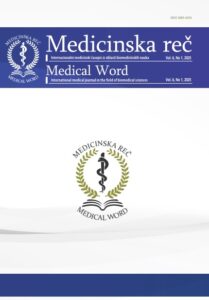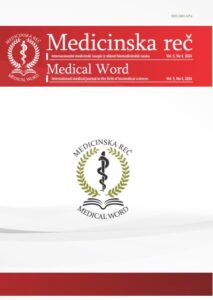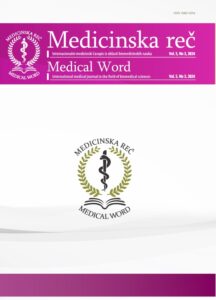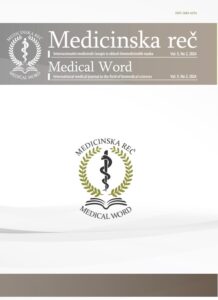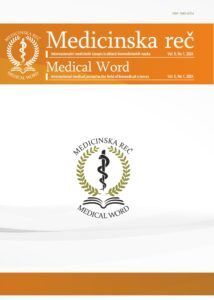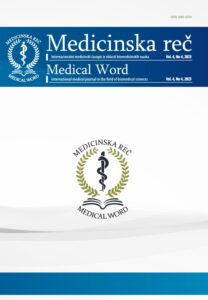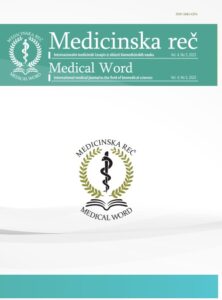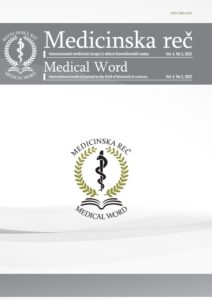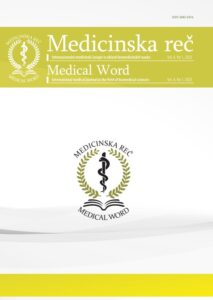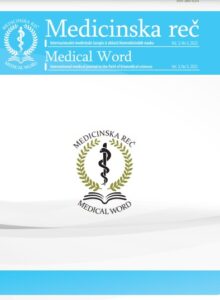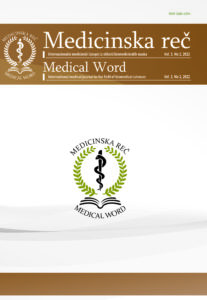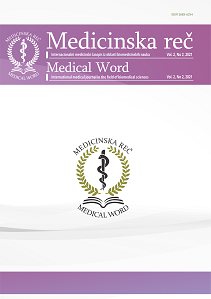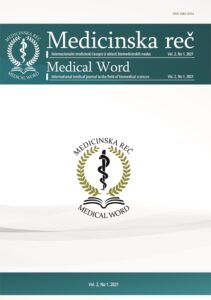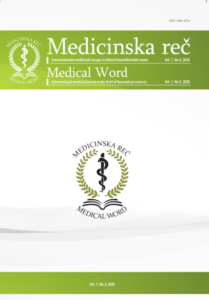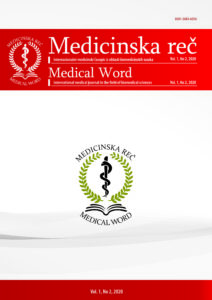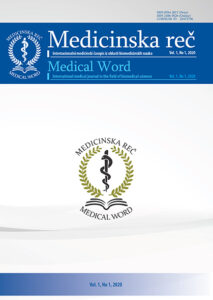Testing of platelet function and application of rotary thromboelastometry in order to rationalize chemotherapy during myocardial revascularization and surgical treatment of heart valves
Danijela Vuković, Tanja Živković, Milena Todorović, Branko Čalija, Petar Vuković, Bela Balint
Med Word 2020; 1(3): 119–126
https://doi.org/10.5937/medrec2003119V
Abstract
Using intraoperative salvage of blood/erythrocytes (ISB/E) in the practice, rationalized application of allogeneic blood products and hemostatic-active drugs – based on “point-of-care” (POC) monitoring findings – it is possible to improve diagnosis and evaluate of transfusion hazards and increase efficacy of therapy of patients with excessive bleedings, with reduction of perioperative morbidity and mortality in cardiac surgery.
This study was performed as a prospective analysis of platelet function using “multiple platelet function analyzer” (MEA; by Multiplate) system and examination of hemostasis by rotational thromboelastometry (ROTEM) during and immediately following myocardial revascularization and surgical treatment of valves in the Institute of Cardiovascular Diseases “Dedinje” for six years period for therapy of 1021 random selected patients.
The study aim was to evaluate the influence of ISB/E and hemostatic drugs – indicated based on the results of platelet count and function (Multiplate) and hemostasis monitoring (ROTEM) in compared to allogeneic transfusions – on the incidence of bleedings, treatment efficiency and overall clinical outcome.
In the perioperative period, a total of 617 (60.4%) patients were treated with ISB/E reinfusion only. Other patients (404; 39.6%) received allogeneic blood components too. Total 391 of them (38.3%) were treated (together by ISB/E) with transfusion of one to three units of allogeneic red blood cells (RBCs). There were only 13 (1.3%) polytransfunded (typically 10 – 15 units) patients. The rate of cardio-surgical reinterventions due to bleeding was only 2.5%.
In conclusion, the application of the ISB/E strategy represents an effective and safe (reduced immune-mediated complications and risk of disease transmission) therapeutic approach. By monitoring MEA/ROTEM and implementation the algorithm of current transfusion therapy, it is possible to reduce significantly of allogeneic blood component therapy. The use of allogeneic RBCs is justified only when the possibilities of autologous transfusion and pharmacological hemostatic therapy have been exhausted.
Key words: bleeding, blood components, cardio-surgery, Multiplate, ROTEM.
References
- Murphy GJ, Reeves BC, Rogers CA, Rizvi SIA, Culliford L, Angelini GD. Increased mortality, postoperative morbiditz, and cost after red blood cell transfusion in patients having cardiac surgery. Circulation 2007; 116: 2544-52.
- Despotis G, Avidan M, Eby C. Prediction and management of bleeding in cardiac surgery. J Thromb Haemost 2009; 7: 111-7.
- Kozek-Langenecker SA, Afshari A, Albaladejo P, Santullano CAA, De Robertis E, Filipescu DC, et al. Management of severe perioperative bleeding: Guidelines from the European Society of Anaesthesiology. Eur J Anaesthesiol 2013; 30: 270-382.
- Geissler RG, Rotering H, Buddendick H, Franz D, Bunzemeier H, Roeder N, et al. Utilisation of blood components in cardiac surgery: A single-centre retrospective analysis with regard to diagnosis-related procedures. Transfus Med Hemother 2015; 42: 75-82.
- Dixon B, Santamaria JD, Reid D, Collins M, Rechnitzer T, Newcomb AE, et al. The association of blood transfusion with mortality after cardiac surgery: cause or confounding. Transfusion 2013; 53: 19-27.
- Vivacqua A, Koch CG, Yousuf AM, Nowicki ER, Houghtaling PL, Blackstone EH, at el. Morbidity of bleeding after cardiac surgery: is it blood transfusion, reoperation for bleeding, or both. Ann Thorac Surg 2011; 91: 1780-90.
- Kuduvalli M, Oo AY, Newall N, Grayson AD, Jackson M, Desmond MJ, et al. Effect of perioperative red blood cell transfusion on 30-day and 1-year mortality following coronary artery bypass surgery. Eur J Cardiothorac Surg 2005; 27: 592-8.
- Scharbert G, Auer A, Kozek-Langenecker S. Evaluation of the platelet mapping assay on rotational thromboelastometry ROTEM. Platelets 2009; 20: 125-30.
- Da Luz LT, Nascimento B, Shankarakutty AK, Rizoli S, Adhikari NKJ. Efect of thromboelastography (TEG) and rotational thromboelastometry (ROTEM) on diagnosis of coagulopathy, transfusion guidance and mortality in trauma: descriptive systematic review. Crit Care 2014; 18: 518.
- Ferreiro JL, Sibbing D, Angiolillo DJ. Platelet function testing and risk of bleeding complications. Thromb Haemost 2010; 103: 1128-35.
- Siller-Matula JM, Francesconi M, Dechant C, Jilma B, Maurer G, Delle-Karth G, et al. Personalized antiplatelet treatment after percutaneous coronary intervention: The MADONNA study. Int J Cardiol 2012; 167: 2018-23.
- Weber CF, Dietrich W, Spannagl M, Hofstetter C, Jámbor C. A point-of-care assessment of the effects of desmopressin on impaired platelet function using multiple electrode whole-blood aggregometry in patients after cardiac surgery. Anesth Analg 2010; 110: 702-7.
- Mammen EF, Koets MH, Washington BC, Wolk LW, Brown JM, Burdick M, et al. Hemostasis changes during cardiopulmonary bypass surgery. Semin Thromb Hemost 1985; 11: 281-92.
- Bolliger D, Görlinger K, Tanaka KA. Pathophysiology and treatment of coagulopathy in massive hemorrhage and hemodilution. Anaesthesiology 2010; 113: 1205-19.
- Ternström L, Radulovic V, Karlsson M, Baghaei F, Hyllner M, Bylock A, et al. Plasma activity of individual coagulation factors, hemodilution and blood loss after cardiac surgery: A prospective observational study. Thromb Res 2010; 126: e128-33.
- Tschoepe D, Schultheiss HP, Kolarov P, Schwippert B, Dannehl K, Nieuwenhuis HK, et al. Platelet membrane activation markers are predictive for increased risk of acute ischemic events after PTCA. Circulation 1993; 88: 37-42.
- Kovač M, Balint B, Bogdanović G. Bazična i klinička transfuziologija. Beograd: Medicinski fakultet; 2020.
- Banbury MK, Brizzio ME, Rajeswaran J, Lytle BW, Blackstone EH. Transfusion increases the risk of postoperative infection after cardiovascular surgery. J Am Coll Surg 2006; 202: 131-8.
- van Straten AH, Kats S, Bekker MW, Verstappen F, ter Woorst JF, van Zundert AJ, et al. Risk factors for red blood cell transfusion after coronary artery bypass graft surgery. J Cardiothorac Vasc Anesth 2010; 24: 413-7.
- Hessel EA 2nd, Levy JH. Guidelines for perioperative blood transfusion and conservation in cardiac surgery: lessons and challenges. Anesth Analg 2010; 111: 1555-9.
- Spalding GJ, Hartrumpf M, Sierig T, Oesberg N, Kirschke CG, Albes JM. Cost reduction of perioperative coagulation management in cardiac surgery: Value of “bedside” thrombelastography (ROTEM). Eur J Cardiothorac Surg 2007; 31: 1052-7.
- Shore-Lesserson L, Manspeizer HE, DePerio M, Francis S, Vela-Cantos F, Ergin MA, et al. Thromboelastography-guided transfusion algorithm reduces transfusions in complex cardiac surgery. Anesth Analg 1999; 88: 312-9.
- Anderson L, Quasim I, Soutar R, Steven M, Macfie A, Korte W. An audit of red cell and blood product use after the institution of thromboelastometry in a cardiac intensive care unit. Transfus Med 2006; 1: 31-9.
- Goerlinger K, Pérez-Ferrer A, Dirkmann D, Saner F, Maegele M, Calatayud AAP, et al. The role of evidence-based algorithms for rotational thromboelastometry-guided bleeding management. Korean J Anesthesiol 2019; 72: 297-322.
- Balint B, Pavlovic M, Ostojic G, Vucetic D, Todorovic M. Improved cytoreductive potential of plateletapheresis in tretmant of symptomatic thrombocytosis: A single center study. Vojnosanit Pregl 2019; 76: 559-60.
- Reece MJ, Klein AA, Alviz EA, Hastings A, Ashwort A, Freeman C, et al. Near-patient platelet function testing in patients undergoing coronary artery surgery: a pilot study. Anaesthesia 2011; 66: 97-103.
- Paniccia R, Antonucci E, Maggini N, Romano E, Gori AM, Marcucci R, et al. Assessment of platelet function on whole blood by multiple electrode aggregometry in high-risk patients with coronary artery disease receiving antiplatelet therapy. Am J Clin Pathol 2009; 131: 834-42.
- Spiess, BD, Tuman KJ, McCarthy RJ, DeLaria GA, Schillo R, Ivankovich AD. Thromboelastography as an indicator of postcardiopulmonary bypass J Clin Monit 1987; 3: 25-30.
- Görlinger K, Jambor C, Hanke AA, Dirkmann D, Adamzik M, Hartmann M, et al. Perioperative coagulation management and control of platelet transfusion by point-of-care platelet function analysis. Transfus Med Hemother 2007; 34: 396-411.
- Rahe-Meyer N, Winterhalter M, Boden A, Froemke C, Piepenbrock S, Calatzis A, et al. Platelet concentrates transfusion in cardiac surgery and platelet function assessment by multiple electrode aggregometry. Acta Anaesthesiol Scand 2009; 53: 168-75.
- Weber CF, Görlinger K, Meininger D, Herrmann E, Bingold T, Moritz A, et al. Point-of-Care Testing: A prospective, randomized clinical trial of efficacy in coagulopathic cardiac surgery patients. Anaesthesiology 2012; 117: 531-47.
- Solomon C, Hartmann J, Osthaus A, Schöchl H, Raymondos K, Koppert W, et al. Platelet concentrates transfusion in cardiac surgery in relation to preoperative point-of-care assessment of platelet adhesion and aggregation. Platelets 2010; 21: 221-8.
- Greinacher A, Kiefel V, Klüter H, Kroll H, Pötzsch B, Riess H. Recommendations for platelet transfusion by the Joint Thrombocyte Working Party of the German Societies of Transfusion Medicine and Immunohaematology (DGTI), Thrombosis and Haemostasis Research (GTH), and Haematology and Oncology (DGHO). Dutsch Med Wochenschr 2006; 131: 2675-9.
- Starost i pol: Popis stanovništva, domaćinstava i stanova 2011 Knjiga 2. Beograd: Republički zavod za statistiku; 2012. www.popis2011.stat.rs.
- Ostojić M, Dimković S, Vasiljević Z, Gajić I, Vukčević V, Seferović P, et al. Preporuke za prevenciju ishemijske bolesti srca. Beograd: Nacionalni komitet za izradu Vodiča kliničke prakse u Srbiji; 2002. http://www.azus.gov.rs/wp-content/uploads/2011/02/ishemijska_bolest_srca.pdf.


